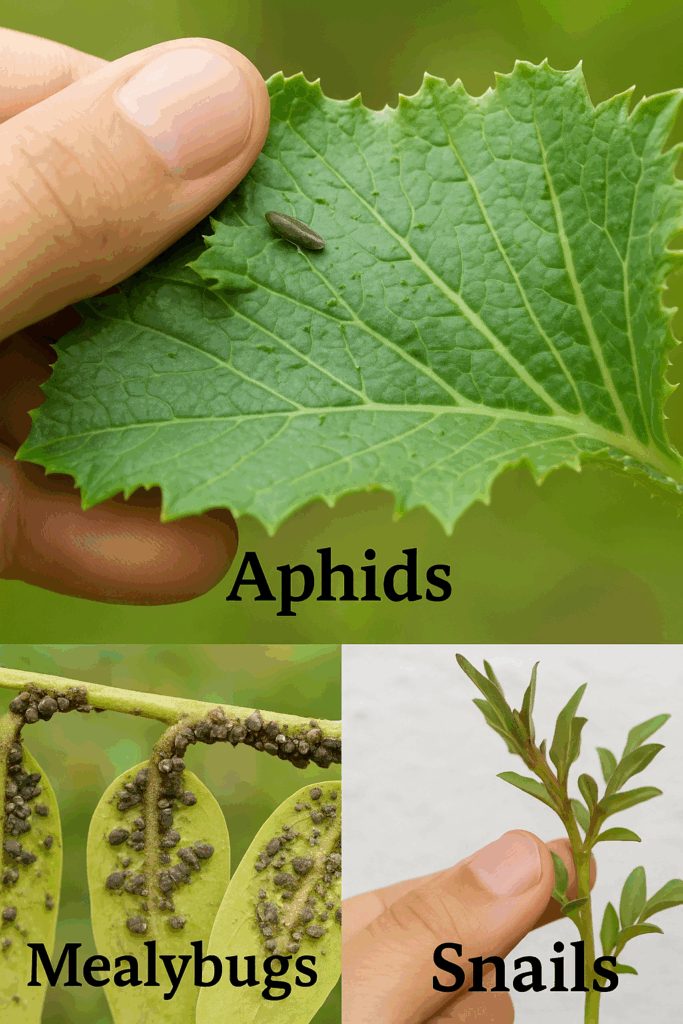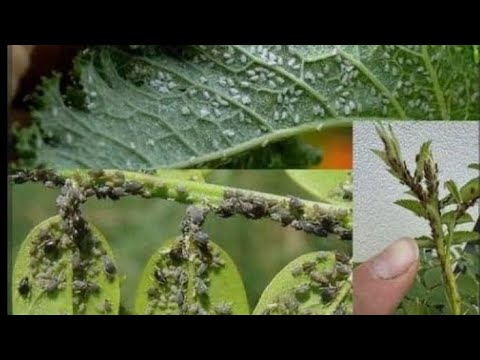Gardening brings joy, satisfaction, and delicious rewards. But every green thumb knows that pests can turn your thriving garden into a battleground. Aphids, mealybugs, and snails are some of the most persistent enemies your plants will face. While chemical pesticides might seem like the easy fix, they often harm beneficial insects and disrupt the delicate balance of your garden ecosystem.
Luckily, nature offers us plenty of powerful and gentle alternatives. In this guide, you’ll discover natural pest control methods that are easy to make, safe to use, and kind to the environment.
🐛 Understanding Common Garden Pests
To fight pests effectively, you need to recognize them early. Here are the main culprits:
- Aphids: Tiny, soft-bodied insects that suck the sap out of plant stems and leaves. They multiply quickly and can cause stunted growth and curled leaves.
- Mealybugs: White, waxy pests that gather in clusters and drain nutrients from the plant, causing yellowing and slow growth.
- Snails and Slugs: Nighttime feeders that leave large holes in leaves and slimy trails behind. They love damp, shaded areas.
🌱 Natural Remedies to Combat Pests
Here are tried-and-true natural remedies you can use to protect your plants—all made from simple household items:
1️⃣ Ash and Water Mixture
Mix 1/3 part wood ash with hot water and add 1 tablespoon of neutral soap. Let it sit for 10 minutes, strain, and pour into a spray bottle. Apply once a week for a month. The ash dries out pests like aphids and mealybugs by absorbing moisture from their bodies.
2️⃣ Garlic Infusion
Crush a garlic clove and soak it in water for 24 hours. Strain the liquid and spray it directly on the affected areas. Garlic’s sulfur compounds naturally repel many types of soft-bodied insects.
3️⃣ Vinegar Spray
Combine 2 tablespoons of vinegar with 1 liter of water. Spray on the underside of leaves where pests often hide. Use sparingly, as too much acidity can damage tender foliage.
4️⃣ Milk Solution
Mix 200 ml of milk with 2 liters of water and spray on your plants. This creates a mild barrier that repels aphids and some fungal diseases. It’s especially useful during humid conditions when mildew can also be an issue.
5️⃣ Diatomaceous Earth
Sprinkle this fine, fossil-based powder at the base of your plants. It tears up the soft bodies of slugs and snails, dehydrating and killing them. Best applied when the ground is dry.
🛠️ Tools and Materials Checklist

Here’s what you’ll need to create your own natural pest defenses:
- 🧄 Garlic cloves
- 🧂 Vinegar
- 🥛 Milk
- 🔥 Wood ash
- 🧼 Neutral soap
- 💧 Spray bottles
- 🐚 Diatomaceous earth
❌ Common Mistakes to Avoid
Even natural solutions can go wrong if not used properly. Watch out for these common gardening slip-ups:
- Overusing Remedies: Too much of a good thing can burn plant leaves or disturb their natural pH.
- Ignoring Beneficial Insects: Insects like ladybugs, lacewings, and hoverflies help control pest populations. Don’t spray them by accident!
- Letting Debris Accumulate: Dead leaves and weeds can shelter pests and their eggs. Keep your garden clean and well-pruned.
🌼 Benefits of Natural Pest Control
Choosing natural over chemical pest control brings several advantages:
- ✅ Eco-Friendly: Reduces harm to pollinators and prevents toxic runoff.
- ✅ Safe for Edible Plants: No toxic residue on your fruits and vegetables.
- ✅ Budget-Friendly: Uses ingredients already in your kitchen.
- ✅ Sustainable: Encourages long-term garden health and biodiversity.
🌍 Seasonal and Regional Tips
Adjust your pest control strategy depending on the time of year:
- 🌸 Spring: Start early with preventive sprays as young shoots emerge. Aphids are especially active.
- ☀️ Summer: Watch for increased snail activity after rain or watering. Diatomaceous earth is particularly helpful now.
- 🍂 Autumn: Clean up plant debris and mulch to remove overwintering shelters for pests.
- 📍 For Mediterranean Climates (like Constantine, Algeria): Monitor carefully during wet winters and hot, dry summers. Pests thrive in humidity, so spacing plants for airflow is crucial.
❓ Frequently Asked Questions
Q: How often should I use these natural remedies?
A: Once a week is a good starting point. Increase frequency if infestations persist, but always monitor plant health.
Q: Can I mix different remedies together?
A: It’s safer to use one solution at a time. Mixing vinegar with milk or garlic, for instance, might harm plants or cancel out the effectiveness.
Q: Are these treatments safe for herbs and vegetables?
A: Yes, but test on a small section first. Sensitive leaves like basil or lettuce may need gentler application.
🌟 Final Thoughts
Natural pest control isn’t just about keeping your plants pretty—it’s about creating a thriving, balanced garden that supports pollinators, nourishes your soil, and yields healthy produce. These easy, homemade treatments allow you to take control of your garden the sustainable way.
So, the next time you spot tiny bugs nibbling on your basil or holes in your lettuce, don’t reach for the chemical spray. Reach for your garlic, vinegar, or milk instead.
🌿 Have you tested any of these remedies in your own garden? Share your results, tips, or variations in the comments below! Let’s help each other grow smarter, greener, and more naturally. 🐞🌸
1. Anchor Text: how to identify common garden pests
- Link: https://www.rhs.org.uk/advice/profile?pid=441
- Why: This Royal Horticultural Society guide provides detailed descriptions and images of common garden pests—great for readers who want to identify what’s eating their plants.
✅ 2. Anchor Text: safe alternatives to chemical pesticides
- Link: https://www.epa.gov/safepestcontrol
- Why: A U.S. Environmental Protection Agency resource that explains natural pest control and when to use it, suitable for eco-conscious readers.
✅ 3. Anchor Text: how to apply diatomaceous earth in your garden
- Link: https://www.gardensalive.com/product/using-diatomaceous-earth-in-the-garden
- Why: A practical guide on how and where to use diatomaceous earth effectively without harming your plants or beneficial insects.


amoxicillin ca – buy amoxil generic buy generic amoxicillin
fluconazole for sale online – https://gpdifluca.com/# fluconazole order online
order cenforce for sale – cenforce rs buy cenforce sale
cialis online no prescription australia – https://ciltadgn.com/# which is better cialis or levitra
generic cialis 20 mg from india – https://strongtadafl.com/# tadalafil walgreens
ranitidine 150mg cost – ranitidine 300mg brand order ranitidine 300mg generic
50 mg generic viagra – https://strongvpls.com/ buy viagra in amsterdam
I couldn’t turn down commenting. Well written! https://gnolvade.com/
This is a topic which is near to my heart… Many thanks! Exactly where can I upon the acquaintance details an eye to questions? aleve and prednisone
This is the stripe of topic I get high on reading. amoxiclav tablet
With thanks. Loads of knowledge! https://prohnrg.com/
This is the description of topic I have reading. https://ondactone.com/spironolactone/
The thoroughness in this break down is noteworthy.
colchicine 0.5mg sale
This is a topic which is forthcoming to my fundamentals… Diverse thanks! Quite where can I upon the acquaintance details for questions? http://web.symbol.rs/forum/member.php?action=profile&uid=1170907
order forxiga 10 mg pills – https://janozin.com/ dapagliflozin 10 mg cost
order xenical without prescription – https://asacostat.com/ xenical 60mg for sale
This is the kind of enter I find helpful. http://sols9.com/batheo/Forum/User-Dpmuwp
You can conserve yourself and your stock nearby being cautious when buying medicine online. Some pharmaceutics websites function legally and offer convenience, solitariness, cost savings and safeguards as a replacement for purchasing medicines. buy in TerbinaPharmacy https://terbinafines.com/product/keppra.html keppra
More posts like this would make the blogosphere more useful. TerbinaPharmacy
More posts like this would force the blogosphere more useful.